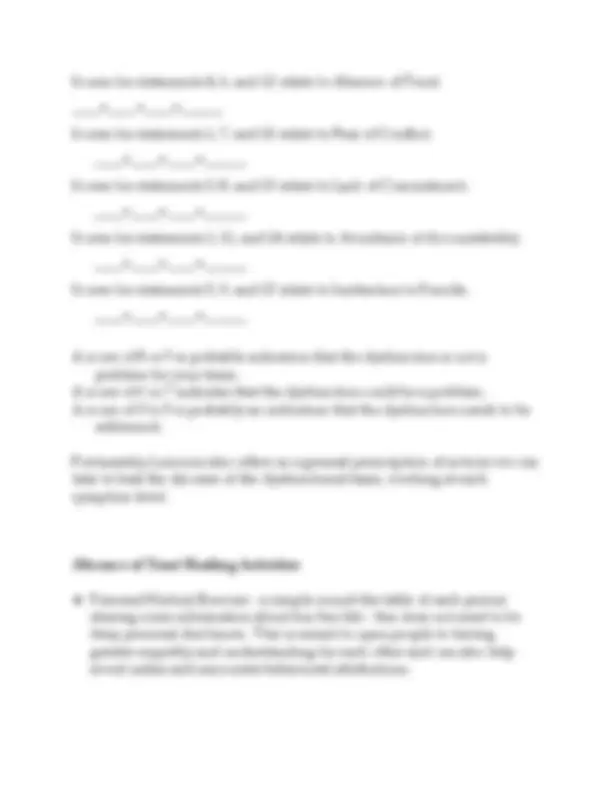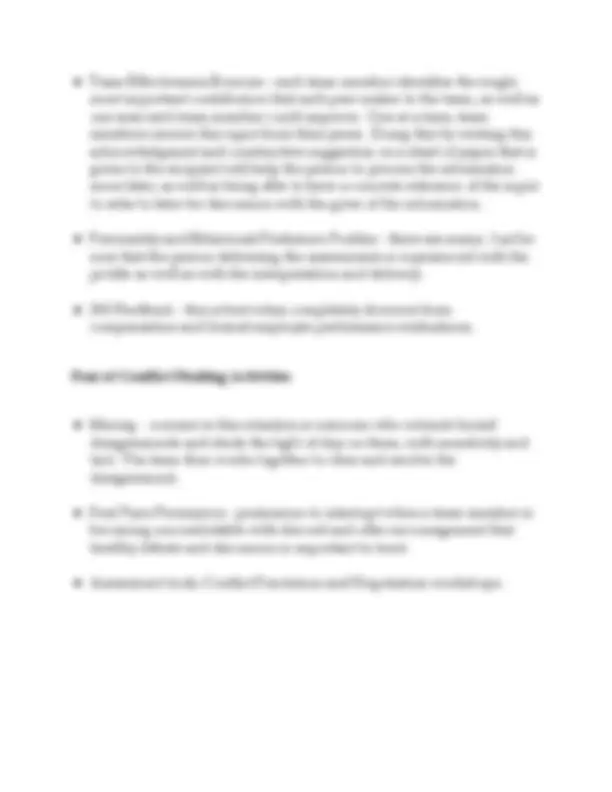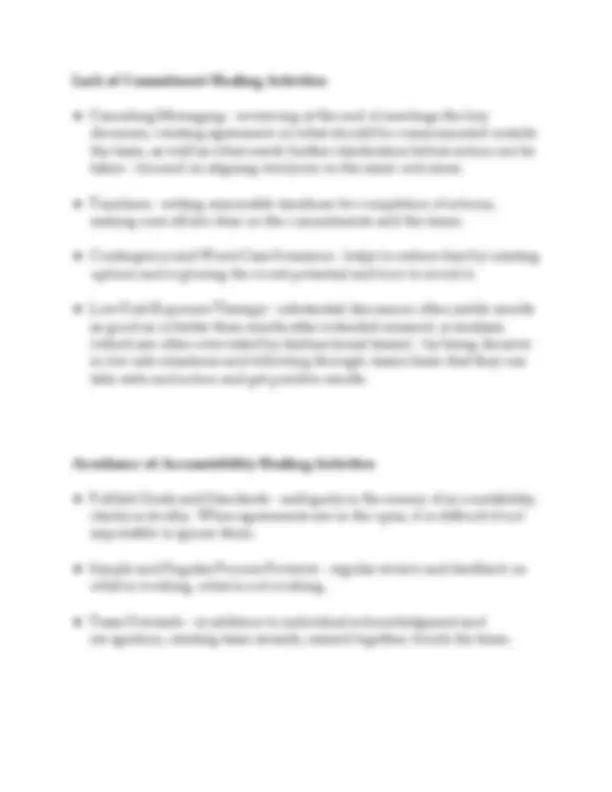





Study with the several resources on Docsity

Earn points by helping other students or get them with a premium plan


Prepare for your exams
Study with the several resources on Docsity

Earn points to download
Earn points by helping other students or get them with a premium plan
Community
Ask the community for help and clear up your study doubts
Discover the best universities in your country according to Docsity users
Free resources
Download our free guides on studying techniques, anxiety management strategies, and thesis advice from Docsity tutors
Patrick Lencioni's book 'The Five Dysfunctions of Team' identifies five common issues that hinder team performance: Absence of Trust, Fear of Conflict, Lack of Commitment, Avoidance of Accountability, and Inattention to Results. a self-assessment tool and healing activities for each dysfunction to improve team function.
Typology: Exams
1 / 6

This page cannot be seen from the preview
Don't miss anything!




Patrick Lencioni (Jossey-Bass Publishers)
Patrick Lencioni in his book The Five Dysfunctions of Teams identifies these five typical symptoms of a team that is not functioning well.
Absence of Trust - the unwillingness to be vulnerable within the group, not genuinely open about their mistakes and weaknesses
Fear of Conflict - if there is a lack of trust, then there is no ability to engage in unfiltered and passionate debate of ideas - resulting in veiled discussions and guarded comments
Lack of Commitment - lack of healthy conflict ensures that team members will rarely buy in and commit to decisions (even though they may say they agree)
Avoidance of Accountability - because of lack of commitment and buy-in to a clear plan of action, team members are reluctant to hold one another accountable on their dysfunction actions
Inattention to Results - the other four dysfunctions result in individual needs (ego, career development, recognition) or departmental competition getting put before the collective goals of the team or organization
Identifying behaviors of your team for each dysfunction will help you determine where you need to focus to improve your team’s function.
Lencioni provides an assessment (see next page) that is helpful in this determination.
Lencioni’s Fifteen Functional Team Skills Rate your team 1 = Rarely, 2 = Sometimes, 3 = Usually
Team members are passionate and unguarded in their discussion of issues.
Team members call out one another’s deficiencies or unproductive behaviors.
Team members know what their peers are working on and how they contribute to the collective good of the team.
Team members quickly and genuinely apologize to one another when they say or do something inappropriate or possibly damaging to the team.
Team members willingly make sacrifices (such as budget, turf, head count) in their departments or areas of expertise for the good of the team.
Team members openly admit their weaknesses and mistakes.
Team meetings are compelling and not boring.
Team members leave meetings confident that their peers are completely committed to the decisions that were agreed upon, even if there was initial disagreement.
Morale is significantly affected by the failure to achieve team goals.
During team meetings, the most important - and difficult - issues are put on the table to be resolved.
Team members are deeply concerned about the prospect of letting down their peers.
Team members know about one another’s personal lives and are comfortable discussing them.
Team members end discussions with clear and specific resolutions and calls to action.
Team members challenge one another about their plans and approaches.
Team members are slow to seek credit for their own contributions, and quick to point out the contributions of others.
Team Effectiveness Exercise - each team member identifies the single most important contribution that each peer makes to the team, as well as one area each team member could improve. One at a time, team members receive this input from their peers. Doing this by writing this acknowledgment and constructive suggestion on a sheet of paper that is given to the recipient will help the person to process the information more later, as well as being able to have a concrete reference of the input to refer to later for discussion with the giver of the information.
Personality and Behavioral Preference Profiles - there are many. Just be sure that the person delivering the assessments is experienced with the profile as well as with the interpretation and delivery.
360 Feedback - this is best when completely divorced from compensation and formal employee performance evaluations.
Fear of Conflict Healing Activities
Mining - a miner in this situation is someone who extracts buried disagreements and sheds the light of day on them, with sensitivity and tact. The team then works together to clear and resolve the disagreement.
Real Time Permission - permission to interrupt when a team member is becoming uncomfortable with discord and offer encouragement that healthy debate and discussion is important to trust.
Assessment tools, Conflict Resolution and Negotiation workshops.
Lack of Commitment Healing Activities
Cascading Messaging - reviewing at the end of meetings the key decisions, creating agreement on what should be communicated outside the team, as well as what needs further clarification before action can be taken - focused on aligning everyone on the same outcomes.
Timelines - setting reasonable timelines for completion of actions, making sure all are clear on the commitments and the times.
Contingency and Worst Case Scenarios - helps to reduce fear by creating options and exploring the worst potential and how to avoid it.
Low Risk Exposure Therapy - substantial discussion often yields results as good as or better than results after extended research or analysis (which are often over-rated by dysfunctional teams) - by being decisive in low risk situations and following through, teams learn that they can take risks and action and get positive results.
Avoidance of Accountability Healing Activities
Publish Goals and Standards - ambiguity is the enemy of accountability, clarity is its ally. When agreements are in the open, it is difficult if not impossible to ignore them.
Simple and Regular Process Reviews - regular review and feedback on what is working, what is not working.
Team Rewards - in addition to individual acknowledgment and recognition, creating team awards, earned together, bonds the team.